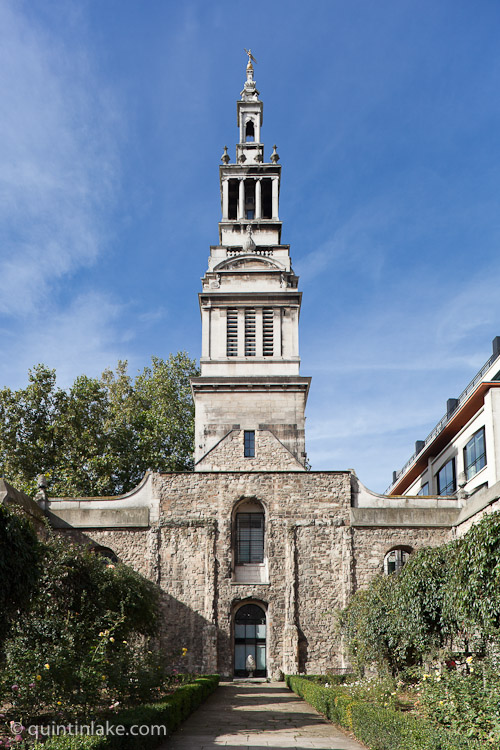
Blitz damaged nave and steeple of Christ Church Greyfriars, by Christopher Wren in the City of London. The tower, rising from the west end of the church, had a simple round-arched main entranceway and, above, windows decorated with neoclassical pediments. Large carved pineapples, symbols of welcome, graced the four roof corners of the main church structure. Unique among the Wren churches, the east and west walls had buttresses. (Photo: Quintin Lake)

Remains of the Second World War damaged nave of Christ Church Greyfriars, London by Christopher Wren, 1687. Former General Post office buildings at right, now Merrill Lynch regional headquarters, contemporary Merrill Lynch offices at rear. (Photo: Quintin Lake)
Christ Church Greyfriars, also known as Christ Church Newgate, was an Anglican church located at the junction of Newgate Street and Montague Street, opposite St Paul’s Cathedral in the City of London. Built first in the gothic style, then in the English Baroque style by Sir Christopher Wren in 1687, it ranked among the City’s most notable pieces of architecture and places of worship.
The church was destroyed in the Second World War during the Blitz on December 29, 1940. A firebomb struck the roof and tore into the nave. Much of the surrounding neighbourhood was also set alight—a total of eight Wren churches burned that night. At Christ Church, the only fitting known to have been saved was the cover of the finely carved wooden font, recovered by an unknown postman who ran inside as the flames raged. The roof and vaulting collapsed into the nave; the tower and four main walls, made of stone, remained standing but were smoke-scarred and gravely weakened. A photograph taken in the light of the following day shows two firemen hosing down smouldering rubble in the nave. The ruins are now a public garden.
In 2002, the financial firm Merrill Lynch completed a regional headquarters complex on land abutting to the north and the west. In conjunction with that project, the Christ Church site got a major renovation and archeological examination. Construction workers put King Edward Street back to its former course so that the site regained its pre-war footprint. The churchyard was spruced up, its metal railings restored. In 2006, work was completed to convert the tower and spire into a modern twelve-level private residence. The nave area continues as a memorial; the wooden font cover, topped by a carved angel, can today be seen in the porch of St Sepulchre-without-Newgate.
These photographs were made during a commission by Thames & Hudson / View Pictures for a book on the architecture of the City of London.
View more images of Christ Church Greyfriars Here
Photography © Quintin Lake, 2010



Lovely shots!
[…] Square or Pilpel’s other outlet in Brushfield Street, Spitalfields, find yourself a nice place to sit and enjoy. Londonist’s resident foodie Chris is also a fan; check out his review of the […]